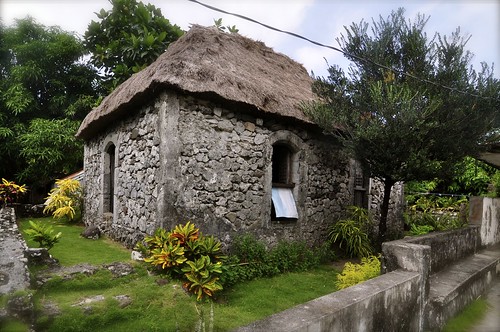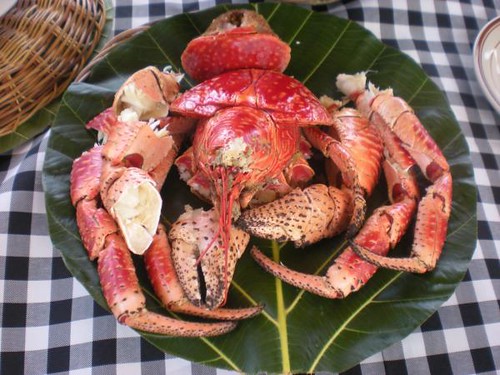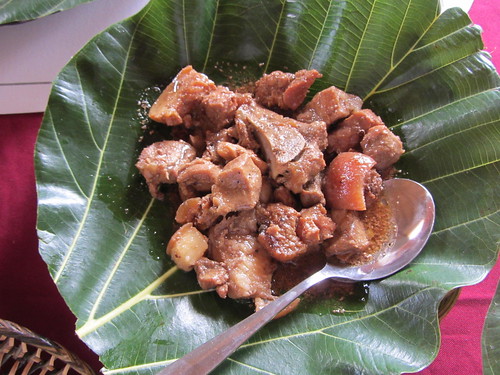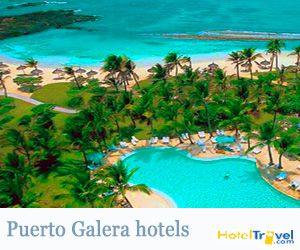
If you want to be one with mother nature, be displaced in an undisturbed serene countryside and experience the charm of the Philippines’ deepest and diversed culture then Batanes is the place to visit. Located at the very tip of the Philippine archipelago, the province of Batanes has hundreds of breathtaking landscapes and desolated coastlines found nowhere in the Philippines. The place’s distinct terrain can be compared to that of New Zealand’s landscapes - rugged but stunning, making it one of the most promising tourist spots in the country. This nature’s wonder is even more enhanced by the equally amazing and most-welcoming people of the province called the Ivatans. The simplicity, honesty and hospitality of the local folks are very eminent, making the visitor’s interaction with the locals quite a pleasant experience. Surprisingly, with the relative isolation of the province from the rest of the country, the population has more than 90% literacy, making it even much easier for foreign and local guests to communicate.
Aside from the beautiful scenery (on any conceivable angle) that the province has to offer, visitors are also free to enjoy major itineraries which include island hoping, trekking, mountain climbing, visiting century old churches and light houses, swimming at beautiful beaches, bird-watching, fishing and, of course, feasting on authentic Batanes cuisines.
Aside from the beautiful scenery (on any conceivable angle) that the province has to offer, visitors are also free to enjoy major itineraries which include island hoping, trekking, mountain climbing, visiting century old churches and light houses, swimming at beautiful beaches, bird-watching, fishing and, of course, feasting on authentic Batanes cuisines.
 The province of Batanes is part of the Cagayan Valley Region located at the northernmost part of the Philippines (approx. 860 km north of Manila ; 190 km south of Taiwan). It lies between the vast waters of Pacific Ocean and South China sea . The province is composed of a group of islands namely : Itbayat, Batan, Sabtang, Ivuhos , Mavudis (Yami) Island, Misanga, Siayan, Dinem and Dequey. Only the first four islands are inhabited and fairly the larger ones. The capital Basco is in Batan Island where most of the establishments and airport are located. Batanes is also considered to be the smallest province in the Philippines in terms of population and land area. The main source of livelihood for the Ivatans are cattle raising, fishing and root crops plantation (garlic, sweet potato etc.). Sugar cane are also harvested to produce local wine (Palek) and vinegar.
The province of Batanes is part of the Cagayan Valley Region located at the northernmost part of the Philippines (approx. 860 km north of Manila ; 190 km south of Taiwan). It lies between the vast waters of Pacific Ocean and South China sea . The province is composed of a group of islands namely : Itbayat, Batan, Sabtang, Ivuhos , Mavudis (Yami) Island, Misanga, Siayan, Dinem and Dequey. Only the first four islands are inhabited and fairly the larger ones. The capital Basco is in Batan Island where most of the establishments and airport are located. Batanes is also considered to be the smallest province in the Philippines in terms of population and land area. The main source of livelihood for the Ivatans are cattle raising, fishing and root crops plantation (garlic, sweet potato etc.). Sugar cane are also harvested to produce local wine (Palek) and vinegar.The climate in Batanes is cool and windy. Temperature is much like of the neighboring Taiwan rather than of the other parts of the Philippines. The temperature can reach down to 7 degrees centigrade during the month of December until the first quarter of the following year. During summer (March to June), the sea is calmer making it the best time to island hop, swim, go fishing and trek.
"Though the province never boast of its busy nightlife and party-like atmosphere, the place’s real beauty lies in its mystic, calmness, diversity, simplicity, authenticity and its mind-rejuvinating nature backdrop. Visiting Batanes for sure will impart a sence of timelessness; as if you were brought to another dimension where everything is simple and indigenous. There’s no better experience than to sip on a cup of freshly brewed coffee while savoring the mystic of the morning mist and spectacular scenery of the place."
History
The early settlers in Batanes was the Astronesians. The free boaters migrated there 4000 years ago and lived in mountain areas called Idjangs. The place later was discovered by the Englishmen in 1687 but did not claim the islands for the Bristish realm. The Spanish explorers however did. In 1783, Batanes was declared part of the Philippines by the Spanish Governor-General Jose Basco. The locals were brought to the lowlands by the government and later were known as the Ivatans.
Local Site Map (use the arrow & zoom keys to navigate the map)
History
The early settlers in Batanes was the Astronesians. The free boaters migrated there 4000 years ago and lived in mountain areas called Idjangs. The place later was discovered by the Englishmen in 1687 but did not claim the islands for the Bristish realm. The Spanish explorers however did. In 1783, Batanes was declared part of the Philippines by the Spanish Governor-General Jose Basco. The locals were brought to the lowlands by the government and later were known as the Ivatans.
Local Site Map (use the arrow & zoom keys to navigate the map)
Local Site Attractions (click link for more info)
BATAN ISLAND
Basco Airport – a uniqe airport built with thick walls to resist typhoon
Mount Iraya – a dormant mountain near the outskirts of Basco that can be hiked
Santo Domingo Church – an 1812 cathedral built in limestone unique for its central belltower
Basco Light house
Radar Tukon – provides a 360 deg overlooking view of the island
Fundacion Pacita – a beautiful lodge that houses antiques and artworks
House of Dakay – old and most visited house (UNESCO protected heritage site)
San Carlos Borromeo Church – an old church built in 1873 by the Dominicans
Mahatao Light House
Valugan Bay – a white sand beach
“Marlboro Country” – breathtaking landscapes of rolling hills and cliffs
San Jose De Ivana Church – a beautiful 1814 church
Honesty Coffee shop – a unique store that lets you leave your payment in a drop box
Ruins of Songsong – an abandoned village that was once ungulfed by a tidal wave
ITBAYAT ISLAND
Itbayat Sta Maria Church – a church built by the community in 1888
Itbayat Airport
Itbayat Burial Caves – an acient burial site used by the early Ivatans
SABTANG ISLAND
Nakabuang White Beach & Arc Cave - a white sand beach
Sabtang Light House
Sabtang San Vicente Ferrer Church – an 1844 structure
Savidug Stone House – unique houses with meter-thick walls and cogon roofs
Chavayan Village – a UNESCO protected site known as little hawai due to its topography
Chavayan Church – a small church just meters from the What to Eat
Dining in Batanes is considered to be a healthy and a unique experience. Why? That is because aside from the fresh catch of the day being served, the Ivatans only use organic ingredients without the presents of any chemical or artificial food seasoning. To tap it off, the Ivatans never use fertilizers in growing their crops so everything is pure and natural. The Ivatans prepare simple yet tasteful meals. Their version of adobo (traditionally - pork sautéed in soy sause, vinegar, garlic and pepper) or Lunies uses only salt and cooked until dried. The province is also famous for their local food such as coconut crab (tatus), flying fish (dibang), lobster (payi), grilled squid (Kananiez), dolphinfish (arayu), yellow rice (supas), ivatan vegetable salad (tamiduk), seaweed soup (humet) and root crops such as kamote (wakay). Food in Batanes depends also on the season as flying fish are abundant during summer while coconut crabs are rare in cold season, but restaurants and hotels offer basically almost the same meal depending on the days catch. Some of them also offer traditional Filipino breakfast like tapsilog (beef strips, fried rice and egg), ham,eggs, burgers and fries. Vegetables and fruits are also profuse around the province.
In case you want to unwind and relax, restaurants also offer beer and wine. You may want to taste their local wine called palek. It is made out of sugar cane and is the century old traditional alcoholic drink of the Ivatans. Drinking palek or beer with the local folks while enjoing the sunset and shoreline views can be an experience to keep.
Festivals and Events
January - Savidug Barrio Fiesta (Sabtang Island)
February to June – fishing season
May - (1) Ivana Town Fiesta (Batan Island)
- (10) Uyugan Town Fiesta (Batan Island)
June - (13) San Antonio Barrio Fiesta (Basco, Batan)
- (26) Batanes Day
- (27) San Joaquin Barrio Fiesta (Valugan, Batan)
August - (8) Basco Town Fiesta (feast of Sto. Domingo)
- (23) Chavayan Barrio Fiesta (Sabtang Island)
October - (1) Sinakan Barrio Fiesta (Sabtang Island)
- (7) Itbayat Barrio Fiesta (Itbayat Island)
- (7) Tukon Barrio Fiesta (Batan Island)
- (26) Sumnanga Barrio Fiesta (Sabtang Island)
November- (4) Mahatao Town Fiesta (Batan Island)
- (27) Itbud Barrio Fiesta (Batan Island)
How to get to Batanes
The province is approx. 1 hr 45 mins ride by plane (Manila to Capital Basco).
South East Asian Airlines(SEAIR) - has daily flights (Manila to Basco, Batanes) Telephone : (+632) 849.0100 *approx. air fare - Php6,000 ($40)
Skypasada – Manila to Basco,Batanes *approx. air fare - Php6,000 ($40)
Basco to Itbayat, Batanes Island *approx. air fare : Php 1,400 ($32)
Festivals and Events
January - Savidug Barrio Fiesta (Sabtang Island)
February to June – fishing season
May - (1) Ivana Town Fiesta (Batan Island)
- (10) Uyugan Town Fiesta (Batan Island)
June - (13) San Antonio Barrio Fiesta (Basco, Batan)
- (26) Batanes Day
- (27) San Joaquin Barrio Fiesta (Valugan, Batan)
August - (8) Basco Town Fiesta (feast of Sto. Domingo)
- (23) Chavayan Barrio Fiesta (Sabtang Island)
October - (1) Sinakan Barrio Fiesta (Sabtang Island)
- (7) Itbayat Barrio Fiesta (Itbayat Island)
- (7) Tukon Barrio Fiesta (Batan Island)
- (26) Sumnanga Barrio Fiesta (Sabtang Island)
November- (4) Mahatao Town Fiesta (Batan Island)
- (27) Itbud Barrio Fiesta (Batan Island)
How to get to Batanes
The province is approx. 1 hr 45 mins ride by plane (Manila to Capital Basco).
South East Asian Airlines(SEAIR) - has daily flights (Manila to Basco, Batanes) Telephone : (+632) 849.0100 *approx. air fare - Php6,000 ($40)
Skypasada – Manila to Basco,Batanes *approx. air fare - Php6,000 ($40)
Basco to Itbayat, Batanes Island *approx. air fare : Php 1,400 ($32)
Alternate route by sea:
MV Ivatan Princess (ferry) - from Currimao, Ilocos Norte to Basco, Batanes every Wednesday and Sunday.
*approx. fare : Php 1,200 ($30)
Batanes Hotels & Inns
*approx. fare : Php 1,200 ($30)
Batanes Hotels & Inns
Batanes Resort (Tel.: (078)533.3444,(078)533 3456 ;Manila at Tel.: 927 2393)
Batanes Seaside Lodge & Restaurant (Tel.: 0921- 2290102 or 0917- 8825609)
Pension Ivatan - (pensionivatan.com)
Ivatan Lodge - (ivatanlodge@yahoo.com)
Shanedel's Inn and Cafe (Tel. 09204470737 / shanedels@yahoo.com)
Tips
The Philippines | Travel Visa | Migration | Hotels | Transport | Traveling Tips
Batanes Seaside Lodge & Restaurant (Tel.: 0921- 2290102 or 0917- 8825609)
Pension Ivatan - (pensionivatan.com)
Ivatan Lodge - (ivatanlodge@yahoo.com)
Shanedel's Inn and Cafe (Tel. 09204470737 / shanedels@yahoo.com)
Tips
Traveling around Batanes needs a lot of walking as public transport is rare in the province. So, you may want to bring a good trekking / hiking shoes for your own comfortablity. Visitors also must require flexible time as boats and air trips can be postponed at any time due to bad weather. It is also advised to bring your own medicines, first aid kit, and other travelling gadgets. Local folks and tour guides will often warn you on the do’s and don’t’s for safety reasons – so just listen to them as these guys are only protecting the visitors safety, afterall, tourism is what the locals are promoting. If you’re planning to visit the province, it is always best to contact your travel agency to give you good and compact iteneraries and a good local tourist guide. So enjoy your trip!
The Philippines | Travel Visa | Migration | Hotels | Transport | Traveling Tips






0 comments:
Post a Comment